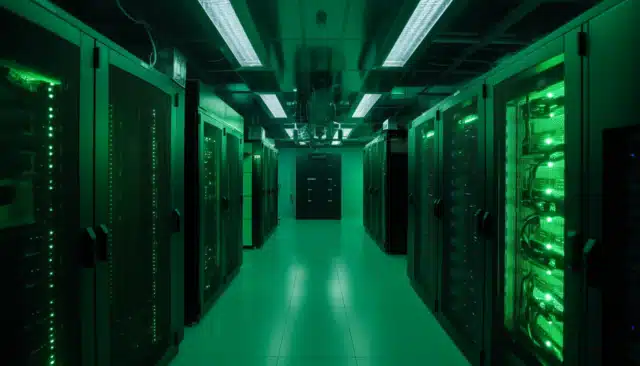Tech must look to build lean to go green

Technology’s role in tackling the growing climate emergency is recognized as a vital one. Yet, the sector's own detrimental contribution to the issue often goes overlooked.
The ever-evolving nature of tech, with constant changes in usage, equipment, and energy efficiency improvements, poses challenges in tracking its carbon footprint. However, projections suggest a concerning trend: by 2040, the ICT sector could contribute 14 percent of the world's carbon footprint, a significant jump from 1.5 percent in 2007.
As the number of IoT devices worldwide skyrockets, AI gets smarter, and the rapid growth of cloud and 5G innovation continues, it becomes crucial for all stakeholders in these domains to acknowledge their role in the need to reduce global emissions.
To curb its environmental footprint, the tech industry needs to embrace a lean approach, striving for greater efficiency with fewer resources. Taking a leadership role in one of the world's most influential and forward-thinking sectors involves addressing a key contributor to pollution -- its use of servers. This commitment would set the stage for a more sustainable and responsible future.
Optimizing code and server infrastructure
Key to the shift towards sustainable business practices is the nuanced integration of technology and greater environmental awareness into their own ecosystems. From the optimization of code and server infrastructure to the strategic use of data centers and Content delivery networks (CDNs), many businesses are confronted with a balancing act -- how best to streamline operations for efficiency while concurrently curbing their environmental footprint.
Our growing reliance on digital services doesn't mean we should operate them wastefully. By optimizing the speed and connectivity of digital services through smartly placing servers at exchange points between networks, we can boost their efficiency and effectiveness.
Estimates suggest that devices, the internet, and supporting systems contribute to 3.7 percent of global greenhouse emissions. To counter this, optimizing code and server infrastructure is a promising solution. This involves selecting efficient algorithms, using profiling tools for fine-tuning, and making smart hardware choices. Businesses aiming for sustainability can cut their energy use and operational expenses. Embracing renewable energy for data centers and employing load-balancing algorithms further enhances operational efficiency.
According to the National Grid ESO, the 400-600 acknowledged commercial data centers in Britain collectively contribute to 2.5 percent of the UK’s total electricity consumption. Up to 40 percent of this energy is allocated to cooling systems for data center HVAC rather than for additional computing performance.
CDNs can play a pivotal role in reversing this negative trend. By strategically positioning servers at exchange points between different networks, they can elicit a significant reduction in energy consumption by minimizing the distance data must travel. This creates a more streamlined and environmentally conscious process for delivering data, reducing our reliance on energy-hungry server hubs.
In addition to the strategic placement of servers, businesses can also make use of green hosting providers that utilize renewable energy sources. According to Ericsson, the ICT sector’s carbon footprint could be reduced by over 80 percent if the electricity it consumed came from renewable energy sources. Green hosting providers prioritize using renewable energy sources, such as solar or wind power, to power their servers and data centers. By partnering with these providers, businesses can ensure that their operations are conducted in an energy-efficient and environmentally responsible manner.
Greener and leaner
Fostering a dedication to continual improvement is crucial for lean development. Keeping digital products agile and in a constant state of refinement reflects a user-centric philosophy that prioritizes user experience and sustainability over mere engagement.
At the heart of this environmental impact strategy is the embrace of a 'going lean' mindset -- maximizing output from available resources. Code reuse becomes pivotal in constructing clean, modular, and efficient software, reducing the likelihood of introducing bugs. This practice aligns with the best standards in software development, resulting in substantial reductions in energy consumption.
While recycling code leads to leaner and more efficient functions, developers should also reassess the value these features bring. Is that new CRM platform needed? Will a new website genuinely boost conversions? Or is this a case of the 'new is better' fallacy? A lean mindset controls costs, neutralizes feature bloat, and enables a focus on what truly matters for a business. Taking on new projects is encouraged, but strict requirements engineering should be the top priority when considering new data-eating products and features.
Moreover, the move towards sustainable development and operations isn't solely propelled by modern businesses; consumers are playing a significant role too. More and more, consumers are showing a preference for environmentally friendly products. A customer interview conducted by IBM and the National Retail Federation revealed that 66 percent of purpose-driven customers favor sustainable products.
In the grand scheme of things, developing sustainable technology isn't just about meeting environmental goals; it's also a unique selling point, particularly for startups looking to attract clients who prioritize sustainability. As we journey through the crossroads of technology and environmental responsibility, every decision businesses make -- from development stages to day-to-day practices -- holds the potential to mold a more sustainable and resilient future for both their ventures and our planet.
Ritam Gandhi is the Founder and Director of Studio Graphene -- a London-based company that specializes in the development of blank canvas tech products, including apps, websites, AR, IoT and more. The company has completed over 250 projects since first being started in 2014, working with both new entrepreneurs and product development teams within larger companies.
